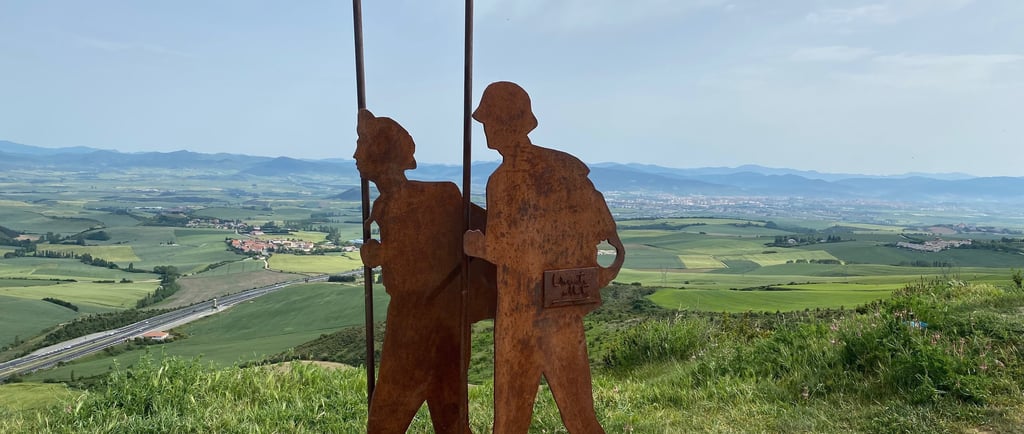DRAWN TO THE CAMINO NEWSLETTER: FEBRUARY 2025
HOW TO PREPARE YOUR BODY FOR THE TRIP? WHAT IS THE TERRAIN LIKE? AND MORE


ARE YOU READY?
Being ready for the Camino is not just about securing gear and hitting the trail. It is also about finding your why.
Why am I doing this and why is it important to do it now? It can be incredibly helpful and meditative to start the sketchbook process in advance of the trip. Capturing, excitement fears, anxiety, or dreams from which you will awake on paper, can be quite cathartic and good practice for when you are on the road. Each one of us needs a reason to provide strength and resilience no matter how great or small. What is yours?
A CAMINO LIFESTYLE: HOW TO PREPARE YOUR BODY FOR THE TRIP
Being a former athlete. I relish the idea of training. There are plenty of websites and training methods for long distance walking but we want you to focus on a few things in the process. The best training is just to start Walking. Now is not the time to try something new. to get into a new program, to hire a trainer and start doing heavy deadlifts, etc. You raise the strong possibility of injuring yourself before the trip even begins. This includes participating in intramural or club sports. If you injure yourself pre-Camino, you will need to be cleared by a doctor to participate. Mapmywalk.com has a laundry list of routes others have taken in their training. If you click on the route you will get a map of it. Some go up to 16 miles all in the local area.
Break in your shoes. At minimum, you need to wear your shoes for 8 hours a day for 14 days. This is a minimum. Many of you have not worn footwear consistently for that long so to get this intimate with a single pair of shoes may be a first. Address issues with your shoes, get insoles and break them in and if they are not at all suitable, return and replace them.
Walk with your pack. Once your shoes are sufficiently broken in, start walking with your pack and get to know your gear.
Practice being alone. This may be the strangest thing to practice but we and everyone else around you will be painfully aware if you are unable to handle time on your own. There is so much amazing landscape and beautiful scenery to waste or miss on idle chit chat. Believe me we have heard it all: from why your family dynamic is so bad to “What if cows had dentures?”
Creating the communal environment of the walk has exercises your independence and feeling of singularity in the world. Make an effort to spend a lot time just doing things solo in public and seeing how one can make a better effort to interact with people. You may have really enjoyed these things in the past, but neglected this alone time because all of the busyness of life creep over in time.
When solo, it is pretty amazing how the smells, the sights, and how one is feeling is experienced so much more vividly. Take the opportunity to meet the friendly, intriguing people that I would have not thought to talk with otherwise (also good practice to figure out how to escape acquaintances that are driving you nuts). Being solo puts ones sensory and observation abilities in overdrive.
Have patience and practice mindfulness. The Camino will train you along the way, making stretching and getting familiar with recuperation is very important to your preparation. Yoga and other restorative practices will help you recuperate and prevent injury.
Read up on how to treat minor aches and pains either by stretches or analgesics. Yes, you will feel pain and you will need to know how to care for yourself to minimize your discomfort from inflammation.
WHAT IS THE TERRAIN LIKE?
When folks are preparing for the Camino de Santiago, they may have wilderness hikes that they have completed in national parks or national trails. However, the Camino de Santiago is not that. It is a moderate hike due to its duration and distance, not difficulty. With every hard day of walking or looming incline, there is a bus, taxi or train that will take you to your destination. And this starts from Day 1 in St. Jean Pied de Port if you take a look at the altitude chart above, This day is hands down the hardest--a combination of not knowing what to expect, a pack, jitters, jetlag and maybe a little too much vino the night before. But taking it a slow and steady approach, you will finish in no time. As the days go one, you will find your trail legs, strength from the repeated endurance training.
So what is the best bit of advice? Start training early with your pack, give yourself rest--a day or two to get over jet lag and days in between to rest on the trail and stay hydrated from the start.



